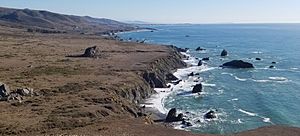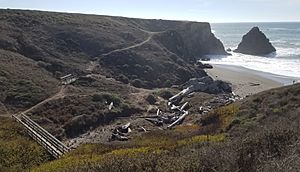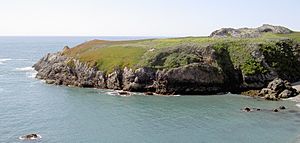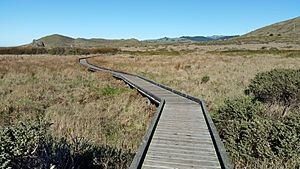Sonoma Coast State Park facts for kids
Quick facts for kids Sonoma Coast State Park |
|
|---|---|
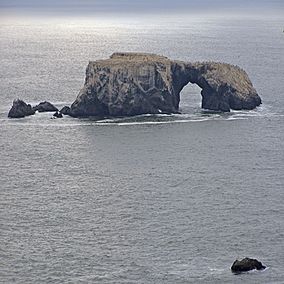 |
|
| Location | Sonoma County, California |
| Nearest city | Jenner |
| Governing body | California Department of Parks and Recreation |
Sonoma Coast State Park is a beautiful park in Sonoma County, California. It stretches along the Pacific Ocean for about 17 miles (27 km). You can find it along Highway 1. The park has many beaches like Arched Rock Beach and Goat Rock Beach. It features sandy shores, rocky areas, and grassy fields high above the ocean.
Contents
How the Coast Was Formed

The coast here is always changing! The ocean and wind slowly wear away the land. On average, the park loses about 1 to 3 feet (30 to 90 cm) of land each year. In stormy years, more land can be lost.
Over a very long time, the land has been pushed up. This created a flat area called a marine terrace. This terrace is about 50 to 100 feet (15 to 30 meters) above the ocean. This creates steep cliffs right above the beaches.
You will see tall rock formations standing out of the water or on the beach. These are called sea stacks. They are like natural sculptures. Sometimes, these rocks are found on the marine terrace. This shows they were once on the ocean floor before the land lifted up. These rocks are made of sandstone with layers of quartz.
The active San Andreas Fault runs close to the coast of Sonoma Coast State Park. The sand on the beaches is usually brown or gray. This is because the cliffs are eroding into the ocean. You can also find patches of smooth pebble beaches, like the one north of Goat Rock.
Amazing Plants and Animals
The park has different types of habitats. These include the ocean, the beaches, and the coastal prairie.
Ocean Life
In the ocean, you might spot gray whales, harbor seals, and California sea lions. Many kinds of fish and other sea creatures live here too. There are also small kelp beds and other ocean plants.
Beach and Tide Pool Creatures
The beaches have fewer creatures than warmer areas. But the tidepools are full of life! You can find many marine plants and animals in these small pools.
The Russian River State Marine Reserve and Russian River State Marine Conservation Area and Bodega Head State Marine Reserve & Bodega Head State Marine Conservation Area help protect the ocean here. These areas are like underwater parks. They help keep the ocean and its wildlife safe.
Coastal Prairie Habitat
The coastal prairie is a grassy area above the cliffs. The soil here drains well. This means it's good for plants. You'll find many grasses and wildflowers. These include different types of lupine, thistle, and wild oats.
Many birds and mammals live on the coastal prairie. You can often see California mule deer. In a year with lots of rain, the plants grow very well.
Park History
Some of the oldest history here involves large animals. About a mile (1.6 km) south of the Russian River, there's a rock formation. It has rubbing marks about two to four meters high. These marks are too high for modern animals to make. Scientists believe mammoths roamed here as recently as 40,000 years ago. They think mammoths made these marks. Mammoth fossils have also been found at Bodega Head.
The first known people to live here were the Native American Coast Miwok and Pomo tribes. People have found old campsites and other signs of tribal life here since 1849.
The park's underwater area goes out about 1,000 feet (300 meters) from the shore. While no shipwrecks have been found, old records suggest 17 ships might have been lost in these waters.
You can also see remains of old barns and farm buildings on the coastal prairie. This shows that Europeans settled here in the 1800s. At Duncans Point, there are iron pins in the cliffs. These are signs of a busy shipping industry in the late 1800s and early 1900s.
Kortum Trail
Some parts of the park are very steep. But the Kortum Trail makes it easy to hike between Highway 1 and the ocean. You can access the trail at Goat Rock, Shell Beach, and Wright's Beach. The trail is about 3.8 miles (6.1 km) long. It is well-kept and has wooden walkways over wet areas and bridges over streams.
Side trails lead to the beach. You can also find places for bouldering at Sunset Boulders. While on the trail, you might see whales in the ocean. You can also spot wildflowers, birds, and deer in the park.
This part of the California Coastal Trail is named after Bill Kortum (1927-2014). He was an environmentalist from Sonoma County. Bill worked to protect California's natural beauty. He helped create the California Coastal Commission.


